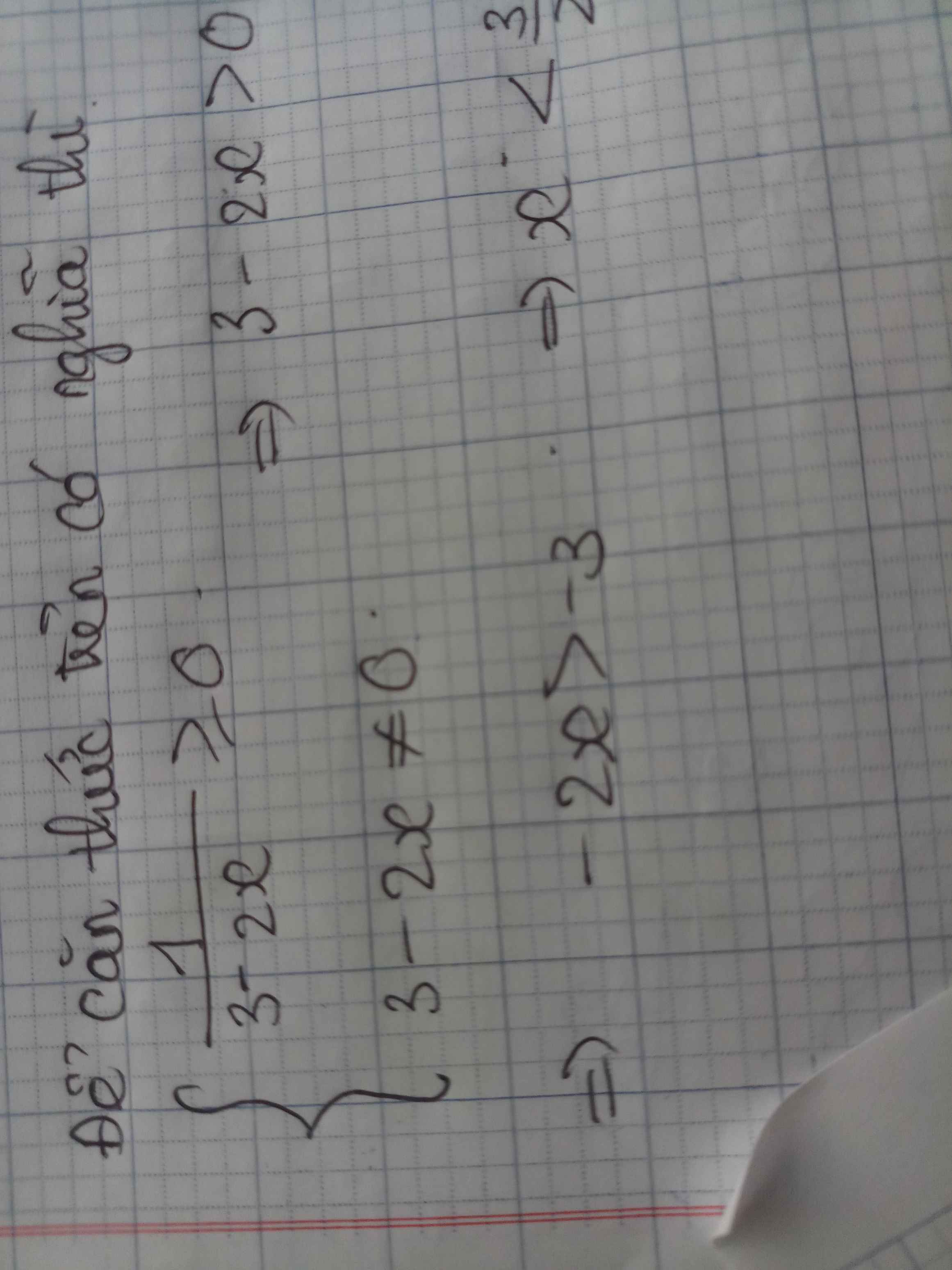Giải hộ mình với ạ :
(x2 + 2x - 3 ) \(\sqrt{2x-1}\) = 0

Những câu hỏi liên quan
Thu gọn các phân thức sau với x≥0
\(\dfrac{2x-2\sqrt{x}+2}{x\sqrt{x}+1}\)
giải chi tiết hộ mình với ạ tại mới học !!!
\(\dfrac{2x-2\sqrt{x}+2}{x\sqrt{x}+1}=\dfrac{2}{\sqrt{x}+1}\)
Đúng 2
Bình luận (1)
\(\dfrac{2x-2\sqrt{x}+2}{x\sqrt{x}+1}=\dfrac{2\left(x-\sqrt{x}+1\right)}{\sqrt{x^3}+1}=\dfrac{2\left(x-\sqrt{x}+1\right)}{\left(\sqrt{x}+1\right)\left(x-\sqrt{x}+1\right)}=\dfrac{2}{\sqrt{x}+1}\)
Đúng 0
Bình luận (0)
g)\(\sqrt{-x^2+4x-5}\)
h)\(\sqrt{x^2+2x+2}\)
i)\(\sqrt{\left(x-1\right)\left(x-3\right)}\)
giải chi tiết hộ mình với ạ !!!
g, \(y=\sqrt{-x^2+4x-5}=\sqrt{-\left(x-2\right)^2-1}\)
\(\Rightarrow\) Hàm số này không xác định với mọi x.
h, \(y=\sqrt{x^2+2x+2}=\sqrt{\left(x+1\right)^2+1}>0\forall x\)
\(\Rightarrow\) Hàm số này xác định với mọi x.
i, \(y=\sqrt{\left(x-1\right)\left(x-3\right)}\) xác định khi:
\(\left(x-1\right)\left(x-3\right)\ge0\)
\(\Leftrightarrow\left[{}\begin{matrix}x-3\ge0\\x-1\le0\end{matrix}\right.\)
\(\Leftrightarrow\left[{}\begin{matrix}x\ge3\\x\le1\end{matrix}\right.\)
Đúng 0
Bình luận (0)
Xem thêm câu trả lời
giải các ptrinh sau: a) \sqrt(6)*x+\sqrt(6)=\sqrt(54)+\sqrt(24) b) (x^(2))/(\sqrt(16))-\sqrt(1,21)=0 c) \sqrt((4x+3)/(x+1))=3 d)(\sqrt(2x-3))/(\sqrt(x-1))=2 e)x-3\sqrt(x)-5=0 nhờ mn giải hộ giúp e với ạ
Xem chi tiết
a: \(\Leftrightarrow\sqrt{6}\left(x+1\right)=5\sqrt{6}\)
=>x+1=5
=>x=4
b: =>x^2/10=1,1
=>x^2=11
=>x=căn 11 hoặc x=-căn 11
c: =>(4x+3)/(x+1)=9 và (4x+3)/(x+1)>=0
=>4x+3=9x+9
=>-5x=6
=>x=-6/5
d: =>(2x-3)/(x-1)=4 và x-1>0 và 2x-3>=0
=>2x-3=4x-4 và x>=3/2
=->-2x=-1 và x>=3/2
=>x=1/2 và x>=3/2
=>Ko có x thỏa mãn
e: Đặt căn x=a(a>=0)
PT sẽ là a^2-a-5=0
=>\(\left[{}\begin{matrix}a=\dfrac{1+\sqrt{21}}{2}\left(nhận\right)\\a=\dfrac{1-\sqrt{21}}{2}\left(loại\right)\end{matrix}\right.\)
=>x=(1+căn 21)^2/4=(11+căn 21)/2
Đúng 2
Bình luận (1)
a) \(\sqrt{\dfrac{1}{3-2x}}\)
Đề bài với giá trị nào của x thì mỗi căn thức sau có nghĩa
giải chi tiết hộ mình với ạ!!!
Để \(\sqrt{\dfrac{1}{3-2x}}\) có nghĩa
Khi\(\dfrac{1}{3-2x}\ge0\)
\(\Leftrightarrow3-2x>0\)
\(\Leftrightarrow-2x< -3\)
\(\Leftrightarrow x>\dfrac{3}{2}\)
Đúng 0
Bình luận (0)
Câu 1: Giải các phương trình sau:
a) 3x-2(x-3)=0
b) (x+1) (2x-3) = ( 2x -1) (x +5)
c) 2x/ x-1 -x/x+1 =1
d) (2x +3) (3x-5)=0
e) x-2/x+2-3/x-2 = 2(x-11)/ x2
giúp mình với ạ huhu\(^{ }\)
\(a,3x-2\left(x-3\right)=0\\ \Leftrightarrow3x-2x+6=0\\ \Leftrightarrow x=-6\\ b,\left(x+1\right)\left(2x-3\right)=\left(2x-1\right)\left(x+5\right)\\ \Leftrightarrow2x^2+2x-3x-3=2x^2-x+10x-5\\ \Leftrightarrow2x^2-x-3=2x^2+9x-5\\ \Leftrightarrow10x-2=0\\ \Leftrightarrow x=\dfrac{1}{5}\\ c,ĐKXĐ:x\ne\pm1\\ \dfrac{2x}{x-1}-\dfrac{x}{x+1}=1\\ \Leftrightarrow\dfrac{2x\left(x+1\right)}{\left(x+1\right)\left(x-1\right)}-\dfrac{x\left(x-1\right)}{\left(x+1\right)\left(x-1\right)}-\dfrac{\left(x+1\right)\left(x-1\right)}{\left(x+1\right)\left(x-1\right)}=0\\ \Leftrightarrow\dfrac{2x^2+2x-x^2+x-x^2+1}{\left(x+1\right)\left(x-1\right)}=0\)
\(\Rightarrow3x+1=0\\ \Leftrightarrow x=-\dfrac{1}{3}\left(tm\right)\)
\(d,\left(2x+3\right)\left(3x-5\right)=0\\ \Leftrightarrow\left[{}\begin{matrix}2x+3=0\\3x-5=0\end{matrix}\right.\\ \Leftrightarrow\left[{}\begin{matrix}x=-\dfrac{3}{2}\\x=\dfrac{5}{3}\end{matrix}\right.\\ e,ĐKXĐ:x\ne\pm2\\ \dfrac{x-2}{x+2}-\dfrac{3}{x-2}=\dfrac{2\left(x-11\right)}{x^2-4}\\ \Leftrightarrow\dfrac{\left(x-2\right)^2}{\left(x-2\right)\left(x+2\right)}-\dfrac{3\left(x+2\right)}{\left(x-2\right)\left(x+2\right)}-\dfrac{2x-22}{\left(x-2\right)\left(x+2\right)}=0\)
\(\Leftrightarrow\dfrac{x^2-4x+4-3x-6-2x+22}{\left(x-2\right)\left(x+2\right)}=0\\ \Rightarrow x^2-9x+20=0\\ \Leftrightarrow\left(x^2-5x\right)-\left(4x-20\right)=0\\ \Leftrightarrow x\left(x-5\right)-4\left(x-5\right)=0\\ \Leftrightarrow\left(x-4\right)\left(x-5\right)\\ \Leftrightarrow\left[{}\begin{matrix}x=4\left(tm\right)\\x=5\left(tm\right)\end{matrix}\right.\)
Đúng 1
Bình luận (0)
ai có thể giúp mình giải bài này với đc không (giải chi tiết hộ mình nhé,xin cảm ơn)Bài 4: a, sqrt{3x+4}-sqrt{2x+1}sqrt{x+3}b, sqrt{2x-5}+sqrt{x+2}sqrt{2x+1}c, sqrt{x+4}-sqrt{1-x}sqrt{1-2x}d, sqrt{x+9}5-sqrt{2x+4}Bài 5:a, sqrt{x+4sqrt{x}+4}5x+2b, sqrt{x^2-2x+1}+sqrt{x^2+4x+4}4VD1 :a,sqrt{2x-1}sqrt{2}-1b,sqrt{x+5}3-sqrt{2}c,sqrt{3}x^2-sqrt{12}0d, sqrt{2}left(x-1right)-sqrt{50}0VD2 :a, sqrt{2x+5}sqrt{1-x}b, sqrt{x^2-x}sqrt{3-x}c, sqrt{2x^2-3}sqrt{4x-3}
Đọc tiếp
ai có thể giúp mình giải bài này với đc không (giải chi tiết hộ mình nhé,xin cảm ơn)
Bài 4:
a, \(\sqrt{3x+4}-\sqrt{2x+1}=\sqrt{x+3}\)
b, \(\sqrt{2x-5}+\sqrt{x+2}=\sqrt{2x+1}\)
c, \(\sqrt{x+4}-\sqrt{1-x}=\sqrt{1-2x}\)
d, \(\sqrt{x+9}=5-\sqrt{2x+4}\)
Bài 5:
a, \(\sqrt{x+4\sqrt{x}+4}=5x+2\)
b, \(\sqrt{x^2-2x+1}+\sqrt{x^2+4x+4}=4\)
VD1 :
a,\(\sqrt{2x-1}=\sqrt{2}-1\)
b,\(\sqrt{x+5}=3-\sqrt{2}\)
c,\(\sqrt{3}x^2-\sqrt{12}=0\)
d, \(\sqrt{2}\left(x-1\right)-\sqrt{50}=0\)
VD2 :
a, \(\sqrt{2x+5}=\sqrt{1-x}\)
b, \(\sqrt{x^2-x}=\sqrt{3-x}\)
c, \(\sqrt{2x^2-3}=\sqrt{4x-3}\)
Bài 4:
a, \(\sqrt{3x+4}-\sqrt{2x+1}=\sqrt{x+3}\) (ĐK: \(x\ge\dfrac{-1}{2}\))
\(\Rightarrow\) \(\left(\sqrt{3x+4}-\sqrt{2x+1}\right)^2\) = x + 3
\(\Leftrightarrow\) \(3x+4+2x+1-2\sqrt{\left(3x+4\right)\left(2x+1\right)}=x+3\)
\(\Leftrightarrow\) \(4x+2=2\sqrt{6x^2+11x+4}\)
\(\Leftrightarrow\) \(2x+1=\sqrt{6x^2+11x+4}\)
\(\Rightarrow\) \(4x^2+4x+1=6x^2+11x+4\)
\(\Leftrightarrow\) \(2x^2+7x+3=0\)
\(\Delta=7^2-4.2.3=25\); \(\sqrt{\Delta}=5\)
Vì \(\Delta\) > 0; theo hệ thức Vi-ét ta có:
\(x_1=\dfrac{-7+5}{4}=\dfrac{-1}{2}\)(TM); \(x_2=\dfrac{-7-5}{4}=-3\) (KTM)
Vậy ...
Các phần còn lại bạn làm tương tự nha, phần d bạn chuyển \(-\sqrt{2x+4}\) sang vế trái rồi bình phương 2 vế như bình thường là được
Bài 5:
a, \(\sqrt{x+4\sqrt{x}+4}=5x+2\)
\(\Leftrightarrow\) \(\sqrt{\left(\sqrt{x}+2\right)^2}=5x+2\)
\(\Rightarrow\) \(\sqrt{x}+2=5x+2\)
\(\Leftrightarrow\) \(5x-\sqrt{x}=0\)
\(\Leftrightarrow\) \(\sqrt{x}\left(5\sqrt{x}-1\right)=0\)
\(\Leftrightarrow\) \(\left[{}\begin{matrix}\sqrt{x}=0\\5\sqrt{x}-1=0\end{matrix}\right.\Leftrightarrow\left[{}\begin{matrix}x=0\\x=\dfrac{1}{25}\end{matrix}\right.\)
Vậy ...
Phần b cũng là hằng đẳng thức thôi nha \(\sqrt{x^2-2x+1}=\sqrt{\left(x-1\right)^2}=x-1\); \(\sqrt{x^2+4x+4}=\sqrt{\left(x+2\right)^2}=x+2\) rồi giải như bình thường là xong nha!
VD1:
a, \(\sqrt{2x-1}=\sqrt{2}-1\) (x \(\ge\) \(\dfrac{1}{2}\))
\(\Leftrightarrow\) \(2x-1=\left(\sqrt{2}-1\right)^2\) (Bình phương 2 vế)
\(\Leftrightarrow\) \(2x-1=2-2\sqrt{2}+1\)
\(\Leftrightarrow\) \(2x=4-2\sqrt{2}\)
\(\Leftrightarrow\) \(x=2-\sqrt{2}\) (TM)
Vậy ...
Phần b tương tự nha
c, \(\sqrt{3}x^2-\sqrt{12}=0\)
\(\Leftrightarrow\) \(\sqrt{3}x^2=\sqrt{12}\)
\(\Leftrightarrow\) \(x^2=2\)
\(\Leftrightarrow\) \(x=\pm\sqrt{2}\)
Vậy ...
d, \(\sqrt{2}\left(x-1\right)-\sqrt{50}=0\)
\(\Leftrightarrow\) \(\sqrt{2}\left(x-1\right)=\sqrt{50}\)
\(\Leftrightarrow\) \(x-1=5\)
\(\Leftrightarrow\) \(x=6\)
Vậy ...
VD2:
Phần a dễ r nha (Bình phương 2 vế rồi tìm x như bình thường)
b, \(\sqrt{x^2-x}=\sqrt{3-x}\) (\(x\le3\); \(x^2\ge x\))
\(\Leftrightarrow\) \(x^2-x=3-x\) (Bình phương 2 vế)
\(\Leftrightarrow\) \(x^2=3\)
\(\Leftrightarrow\) \(x=\pm\sqrt{3}\) (TM)
Vậy ...
c, \(\sqrt{2x^2-3}=\sqrt{4x-3}\) (x \(\ge\) \(\dfrac{\sqrt{3}}{2}\))
\(\Leftrightarrow\) \(2x^2-3=4x-3\) (Bình phương 2 vế)
\(\Leftrightarrow\) \(2x^2-4x=0\)
\(\Leftrightarrow\) \(2x\left(x-2\right)=0\)
\(\Leftrightarrow\) \(\left[{}\begin{matrix}2x=0\\x-2=0\end{matrix}\right.\)
\(\Leftrightarrow\) \(\left[{}\begin{matrix}x=0\left(KTM\right)\\x=2\left(TM\right)\end{matrix}\right.\)
Vậy ...
Chúc bn học tốt! (Có gì không biết cứ hỏi mình nha!)
Đúng 0
Bình luận (2)
Giải hệ phương trình sau:
a) { 2x + 5y=11
{2x - 3y =0
B) { 4x + 3y = 6
{ 2x + y = 4
Ai giải bài toán này hộ mình với ạ , mình cảm ơn
Xem chi tiết
`2x+5y=11(1)`
`2x-3y=0(2)`
Lấy (1) trừ (2)
`=>8y=11`
`<=>y=11/8`
`<=>x=(3y)/2=33/16`
Đúng 1
Bình luận (0)
a) Ta có: \(\left\{{}\begin{matrix}2x+5y=11\\2x-3y=0\end{matrix}\right.\)
\(\Leftrightarrow\left\{{}\begin{matrix}8y=11\\2x-3y=0\end{matrix}\right.\Leftrightarrow\left\{{}\begin{matrix}y=\dfrac{11}{8}\\2x=3y=3\cdot\dfrac{11}{8}=\dfrac{33}{8}\end{matrix}\right.\)
\(\Leftrightarrow\left\{{}\begin{matrix}x=\dfrac{33}{16}\\y=\dfrac{11}{8}\end{matrix}\right.\)
Vậy: Hệ phương trình có nghiệm duy nhất là \(\left\{{}\begin{matrix}x=\dfrac{33}{16}\\y=\dfrac{11}{8}\end{matrix}\right.\)
b) Ta có: \(\left\{{}\begin{matrix}4x+3y=6\\2x+y=4\end{matrix}\right.\)
\(\Leftrightarrow\left\{{}\begin{matrix}4x+3y=6\\4x+2y=8\end{matrix}\right.\Leftrightarrow\left\{{}\begin{matrix}y=-2\\2x+y=4\end{matrix}\right.\)
\(\Leftrightarrow\left\{{}\begin{matrix}2x-2=4\\y=-2\end{matrix}\right.\Leftrightarrow\left\{{}\begin{matrix}2x=6\\y=-2\end{matrix}\right.\Leftrightarrow\left\{{}\begin{matrix}x=3\\y=-2\end{matrix}\right.\)
Vậy: Hệ phương trình có nghiệm duy nhất là (x,y)=(3;-2)
Đúng 1
Bình luận (0)
`b)4x+3y=6(1)`
`2x+y=4<=>4x+2y=8(2)`
Lấy (1) trừ (2) ta có:
`y=-2`
`<=>x=(4-2y)/2=3`
Đúng 1
Bình luận (0)
Xem thêm câu trả lời
giải BPT : a) (1-x)(2x+5) > 0 b) (3-x)(x+5) < 0 c) (3x-7)(5-x) > 0
GIải hộ mình với nha cảm ơn nhiều ạ <3
giải dùm mình với ạ <3
1. \(\sqrt{x+2}+x^2-x-2\le\sqrt{3x-2}\)
2. \(\sqrt{2x+1}+\sqrt[4]{2x-1}< \sqrt{x-1}+\sqrt{x^2-2x+3}\)
3. \(\sqrt[3]{3-2x}+\frac{5}{\sqrt{2x-1}}-2x\le6\)
4. \(\left(x+3\right)\sqrt{x+1}+\left(x-3\right)\sqrt{1-x}+2x=0\)
























